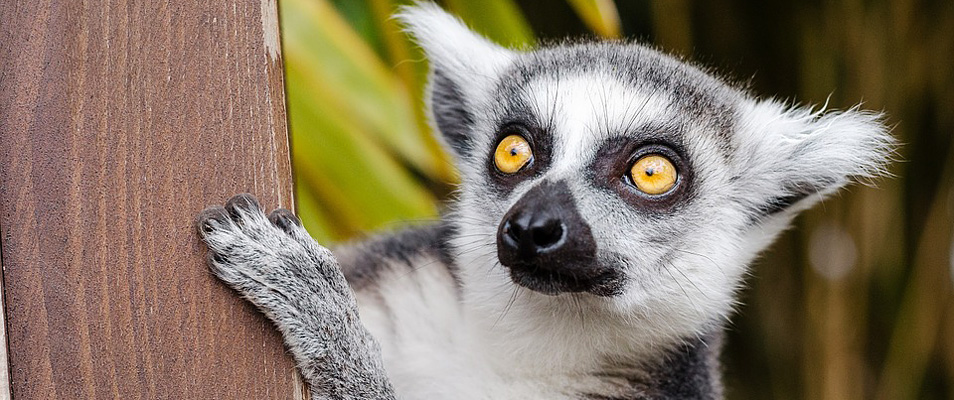By Alondra Abreu
Not all pets are domesticated, and the wild ones are finding homes in New York City.
Miranda Herrera, 35, has two lemurs and she says she does her best to create their natural habitat in her small apartment. “You need to accommodate your house and remove all things like chandeliers, ceiling fans, lamps, pictures, curtains, decorations, and wall mounted TV’s,” said Herrera. “They love to hang from objects. You can take the animal out of the wild, but you can’t take the wild out of the animal.” Aside from her lemurs, Herrera also has a snake, Scarlett, a dog, Phoebe, and a water monitor, Jaws who is 4 years old.
New York City is famous among exotic pet enthusiasts for its stringent pet restrictions. Common animals in the pet trade such as ball pythons, ferrets, and tarantulas are banned. Some residents still keep them illegally and say that owning an exotic pet is not any different from owning a dog or cat. According to American Pet Products Association, 19.4 million U.S households owned exotic pets in 2013.
“I’ve sacrificed a lot of my time, retreats, and family to keep my babies,” said Herrera. “But I wouldn’t have it any other way.” Herrera, or as she calls herself “lemur mom,” has two lemurs Rupert, and Gus, who live with her in home along with her three kids, Oliver, 7, Alice, 6, and Jack, 1. She says her lemurs are very loving to her immediate family but don’t work well with strangers or distant family members. “At the age of 2 they become aggressive to anyone who doesn’t live with you,” she said. Therefore, when family visits she must cage her lemurs for them not to attack or in some cases groom the visitors.
 On Pet Day, April 11, when many were showing off their little furry friends, Herrera brought her venomous, not so furry, pets out to play. She says it’s not an easy job to maintain exotic pets and advises people to look at their state regulations. “I was able to keep my lemurs because I’ve had them for so long,” she said. “Others aren’t as fortunate.”
On Pet Day, April 11, when many were showing off their little furry friends, Herrera brought her venomous, not so furry, pets out to play. She says it’s not an easy job to maintain exotic pets and advises people to look at their state regulations. “I was able to keep my lemurs because I’ve had them for so long,” she said. “Others aren’t as fortunate.”
Even within the state, animal bans exist in certain cities, counties, and neighborhood associations. To know which pets are generally allowed, you should investigate the specific regulations that apply to you and your city, and always check with your state, county, town, to confirm whether it is legal to keep an exotic animal for private possession.
There is a grandfather clause for those who owned a wild animal as a pet before the New York City law went into effect. Those owners can keep their pets for the remainder of their lives. That is if the person has not been convicted of any offense relating to cruelty to animals. They also must follow all rules and regulations established by the department, depending on the breed of the pet.
“I’m not allowed to keep my albino blood python,” said Raven Miller, 22. “I had to give her away due to her size. In New York, ‘large’ constrictor snakes are illegal.” The t-negative blood python, Ouija, 4, was five feet in length and weighed 13 pounds. “After six months, they outgrow the small tubs,” said Miller. “And you must move them to larger tanks in order for them to stretch, be comfortable, and grow.”
Aside from moving them to different compartments, you must also maintain the tank temperature to 80-82 degrees Fahrenheit during the day and allow the temperature to drop to 78 degrees for an overnight low. “However, you must also be careful,” said Miller. “Extreme warm temperatures can cause unnecessary stress.”
Miller also warns about overfeeding snakes, “By the time Ouija was 3 years old we were only giving her a medium sized rat every 14 days,” she said. “If your snake is gaining too much weight try giving it smaller meals or only feed them every 21 days.” Miller laments having to give away her snake due to her size, so on her free time she makes custom chains, earrings, and bracelets of python for snake lovers just like her.
Although, Herrera’s pet concerns aren’t the same as Miller’s, she has come across other challenges. “The teachers have stopped calling and have switched to texting,” said Herrera with a smile. “Oliver’s behavior is really out of hand. He’ll grab a worm, run after a lizard, and he gets my entire class get out of hand,” said Herrera as she read a text aloud. Yet, that doesn’t bother Herrera because she feels Oliver is really in touch with nature and his surroundings.
Some people only collect one type of animal, birds. Lucia Fernandez, 56, has three, 2-year-old African Greys, two Lear’s Macaw, and a sugar glider. “I love my birds but my little sugar glider, Pinky, is an unstoppable force,” says Fernandez. “He has so much energy and jumps all over my house.” The sugar glider is a marsupial that carries its young in a pouch like a kangaroo. Skin membranes that stretch between its front and rear legs allow it to “glide” through the air for up to 150 meters. “And he’s nocturnal,” said Hernandez, “which makes him my companion while I watch a late-night movie and snack.”
Fernandez has always had African Greys at home, mainly because she lives by herself and gets lonesome. “They talk, sing, dance, and are friendly,” she says. “Where would I be or what would I do without my wild pets?”














No comments